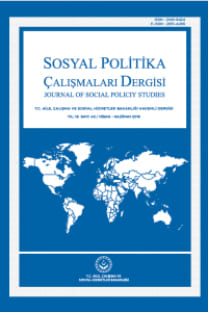APPROACHING THE END ‘EUROPE 2020’: NEET
This paper provides a literature review on the group aged between 15-24, who are not in employment, education or training (NEET) and it examines the current situation in the European Union (EU) at macro level. Since young unemployment is one of the major concerns of the EU, investing in human capital is essential both for employability and social inclusion of the youth. Since the recent objectives of the EU aim to tackle ageing population and high rates of young unemployment; and to obtain smart, sustainable and inclusive growth in addition to worldwide competitiveness, they emphasise on the crucial role of the young population. This paper tries to answer the question whether the ‘Europe 2020’ is successful in terms of coping with the problem of NEET. While analysing this issue, firstly it examines the categorisation and the potential reasons for being NEET. Then, in the light of the current data of the second quarter of 2019, it figures out the state of play considering the targets of ‘Europe 2020’. It demonstrates that the success cannot be achieved by the data regarding merely employment and education. Moreover, it focuses on the risks emerged both on the economic and social areas due to remaining outside the education and labour market. Lastly, criticism towards the current policies of the EU and recommendations for the following strategy document is presented.
Anahtar Kelimeler:
Europe 2020, NEET, , young unemployment, , labour market, , social inclusion
Keywords:
Europe 2020, young unemployment, labour market, social inclusion, NEET, social inclusion,
___
- Balan, M. (2017). ‘European and National Policies Regarding Social Inclusion of NEET Youths’. Hyperion International Journal of Econophysics & New Economy. Vol. 10 Issue 2, p.136-156.
- Communication from the Commission. (2010). Europe 2020 A Strategy for Smart, Sustainable and İnclusive Growth.
- Delmas, A. (2015). ‘Perspectives for revision of the Europe 2020 Strategy’. Opinions of The Economic, Social and Environmental Council.
- ETF (2015). ‘Young People Not in Employment, Education or Training (NEET). An Overview In ETF Partner Countries’.
- Eurofound (2012a), ‘NEETs – Young people not in employment, education or training: Characteristics, costs and policy responses in Europe’, Publications Office of the European Union, Luxembourg.
- Eurofound (2012b), Recent policy developments related to those not in employment, education and training (NEETs). Available from: https://www.eurofound.europa.eu/observatories/emcc/comparative-information/recent-policy-developments-related-to-those-not-in-employment-education-and-training-neets
- Eurofund. (2012c). ‘Young People and ‘NEET’s’ infographic’. Available from: https://www.eurofound.europa.eu/emcc/labourmarket/youthinfographic
- Eurofound (2016), ‘Exploring the diversity of NEETs’, Publications Office of the European Union, Luxembourg
- Eurofound (2017), Long-term unemployed youth: Characteristics and policy responses, Publications Office of the European Union, Luxembourg.
- Eurofund (2018). ‘NEETs’. Available from: https://www.eurofound.europa.eu/topic/neets.
- OECD (2019), Youth not in employment, education or training (NEET) (indicator). doi: 10.1787/72d1033a-en (Accessed on 19 May 2019).
- For table preparation: Eurostat.
- ISSN: 2148-9424
- Yayın Aralığı: Yılda 4 Sayı
- Başlangıç: 2012
- Yayıncı: Aile,Çalışma ve Sosyal Hizmetler Bakanlığı
Sayıdaki Diğer Makaleler
BEŞ YAŞ ALTI ÖLÜMÜ ÜZERİNDE YOKSULLUK VE SAĞLIKTA DÖNÜŞÜM PROGRAMININ ETKİSİ
SURİYELİ GÖÇMENLERİN SAĞLIK OKURYAZARLIĞI VE YAŞAM DOYUMLARININ İNCELENMESİ
Melek ZUBAROĞLU YANARDAĞ, Özlem ÖZER, Fatih BUDAK
“YAPAY” BİR ÇOCUK KORUMA MODELİ OLARAK SOS ÇOCUK KÖYLERİ VE TÜRKİYE’DEKİ UYGULAMALARI
Sebahat Sevgi UYGUR, Esra ASICI, Derya SARI
ÇOCUKLARIN BOŞANMAYA VE EBEVEYNLERİNE İLİŞKİN ALGILARI
Orhan KOÇAK, Raziye DEMİREL, Mehmet KIRLIOĞLU
APPROACHING THE END ‘EUROPE 2020’: NEET
ÇOCUK ADALET SİSTEMİNDE SUÇA SÜRÜKLENEN ÇOCUKLARA YÖNELİK UYGULAMALARDA KARŞILAŞILAN SORUNLAR
